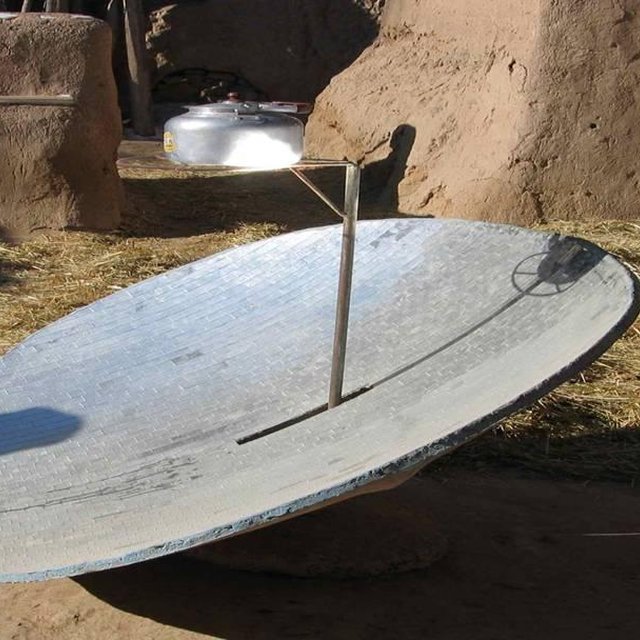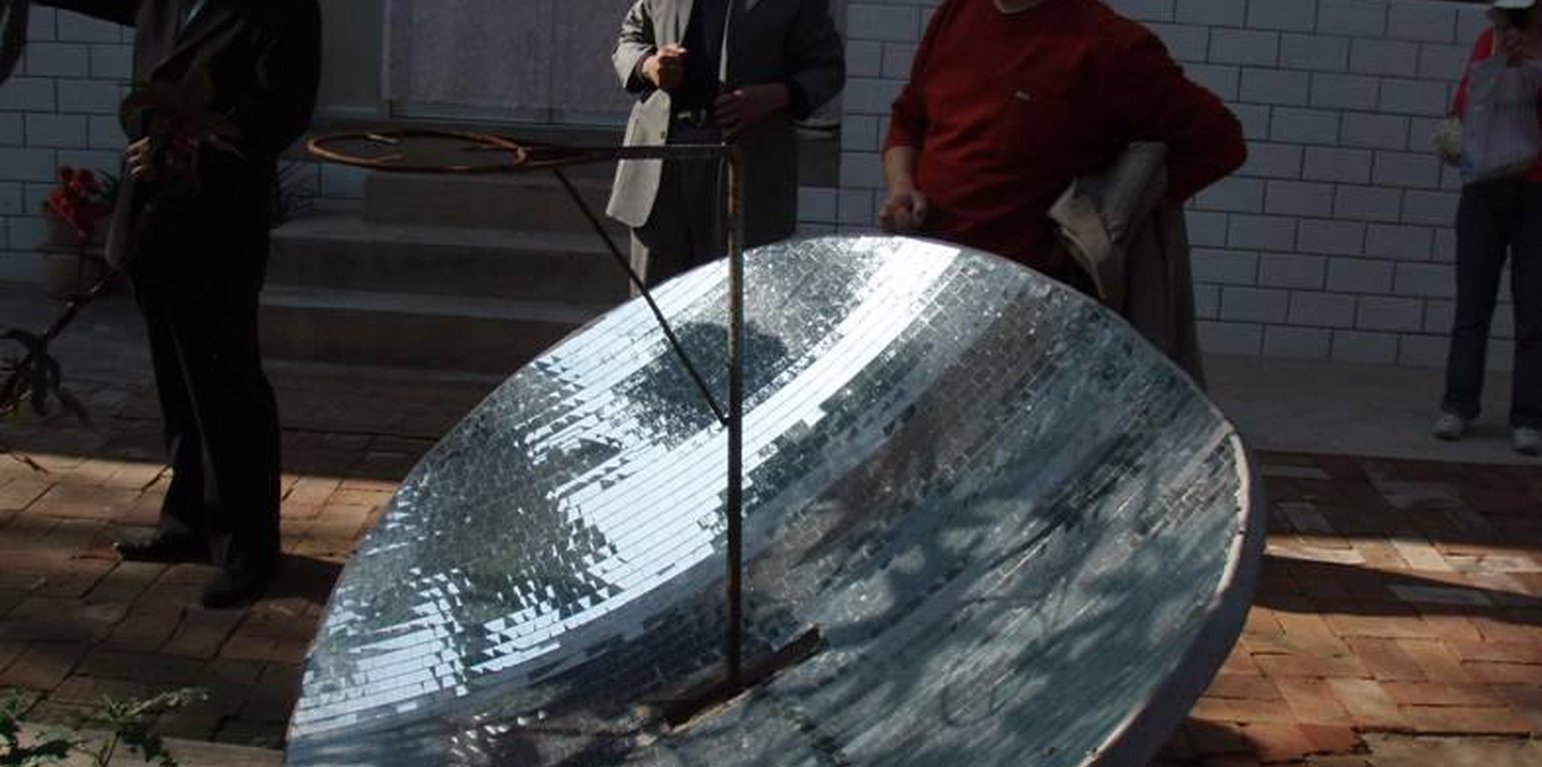Solar Stove for Rural Communities
(China)
Description
Solar stoves use solar energy for cooking, featuring environmental-friendly, zero pollution, low cost, easy operation and maintenance, safe and convenient use, saving firewood, etc. To operate the stove, adjust condenser aiming at the sun with the spot on stove or other objects to be heated.
Qinghai has high elevation, with intense and long sunshine to suit dissemination of the technology to compensate for the shortage of fuel in the countryside, effectively reducing the labor in wood/grass cutting and vegetation destruction, protecting the environment and promoting soil degradation control. Therefore the technology has significant ecological and social benefits.
Restrictions in use: it can only be operated when sunlight is available; operation requires manual adjustment of aim from time to time (lack of sunlight auto-tracking technology application) resulting in an operative time efficiency of about 40%. Solar stove dissemination is financed by the government with labor input by farmers and herdsmen. International financial aid is utilized as an effective incentive for implementation. Publicity and demonstration were conducted to attract more families to use solar stoves. Farmers are the users and beneficiaries so that training to them on operation and maintenance should be conducted.
In 2005, the solar stove dissemination started and so far 150 units have been in operation representing 28% of total demonstration households. Satisfactory results have been achieved. At present, Qinghai provincial government provides special financial support to the dissemination of solar stove extension so the technology application has a bright prospect.
Location
![]()
Location: Shazhuyu pilot of Gonghe County, Qinghai Province, China
Geo-reference of selected sites
Initiation date: 2005
Year of termination: n.a.
Type of Approach
-
traditional/ indigenous
-
recent local initiative/ innovative
-
project/ programme based

Using the solar stove for heating water. (Zhang Peng )
Approach aims and enabling environment
Main aims / objectives of the approach
Aims of the approach are to: - form the technology dissemination mechanism that integrates related organizations; - carry out environmental awareness education and raise community participation level; - develop technical training to raise the community's capability in ecological protection; - use alternative energy to solve the rural fuel insufficiency problem and to alleviate the pressure on the environment; - Protect and increase vegetation cover and improve ecological conditions
The SLM Approach addressed the following problems: - lack of fuel and firewood cutting damage vegetations in the rural area; - serious soil and water erosion ; - topsoil losses; - decline of soil fertility.
Conditions enabling the implementation of the Technology/ ies applied under the Approach
Conditions hindering the implementation of the Technology/ ies applied under the Approach
-
Availability/ access to financial resources and services: Farmer households are poor and short of funds
Treatment through the SLM Approach: Government provides financial support with counterpart funds from households. Access to international assistance.
-
Knowledge about SLM, access to technical support: The technology is not mature. Most solar stoves are artificially operated unable of tracking automatically the sun. Weather condition may also affect the use efficiency.
Treatment through the SLM Approach: Research and developemnt to resolve the technical problems and reduce the cost.
Participation and roles of stakeholders involved
Stakeholders involved in the Approach and their roles
| What stakeholders / implementing bodies were involved in the Approach? |
Specify stakeholders |
Describe roles of stakeholders |
| local land users/ local communities |
|
|
| national government (planners, decision-makers) |
|
|
Involvement of local land users/ local communities in the different phases of the Approach
none
passive
external support
interactive
self-mobilization
initiation/ motivation
Accept education of solar energy technology
planning
The participatory planning on solar stove extension
implementation
Use and disseminate solar stoves
monitoring/ evaluation
Monitoring and evaluation of the solar stove application
Decision-making on the selection of SLM Technology
Decisions were taken by
-
land users alone (self-initiative)
-
mainly land users, supported by SLM specialists
-
all relevant actors, as part of a participatory approach
-
mainly SLM specialists, following consultation with land users
-
SLM specialists alone
-
politicians/ leaders
Decisions were made based on
-
evaluation of well-documented SLM knowledge (evidence-based decision-making)
-
research findings
-
personal experience and opinions (undocumented)
Technical support, capacity building, and knowledge management
The following activities or services have been part of the approach
-
Capacity building/ training
-
Advisory service
-
Institution strengthening (organizational development)
-
Monitoring and evaluation
-
Research
Capacity building/ training
Training was provided to the following stakeholders
-
land users
-
field staff/ advisers
Form of training
-
on-the-job
-
farmer-to-farmer
-
demonstration areas
-
public meetings
-
courses
Subjects covered
The training includes solar stove installation, operation and maintenance is conducted in form of site demonstration; The effect of training to households especially the training to woman is acceptable.
Institution strengthening
Institutions have been strengthened / established
-
no
-
yes, a little
-
yes, moderately
-
yes, greatly
Describe institution, roles and responsibilities, members, etc.
Type of support
-
financial
-
capacity building/ training
-
equipment
Further details
Application of the technology changes the villager's energy consumption manner, with decreased expenditure and increased income. Therefore it is helpful for poverty reduction and environmental protection. The extension also promoted the capacity building of local forestry organizations.
Monitoring and evaluation
bio-physical aspects were monitored through measurements; indicators: Site measure the light application time and illumination intensity
technical aspects were monitored through measurements; indicators: Hours of soalr stove use (the use rate). Estimate the quantity of firewood saving.
socio-cultural aspects were monitored through measurements; indicators: Survey the villagers acceptance to the technology and comments from women
economic / production aspects were monitored through measurements; indicators: Calculate the economic value equivalent to standard coal.
area treated aspects were monitored through measurements; indicators: Survey the number of household users
management of Approach aspects were monitored through measurements; indicators: Survey regularly the household users, monitor and evaluate their feedback information
There were changes in the Approach as a result of monitoring and evaluation: Adopt the participatory type and not the administrative type of extension approach.
Research
Research treated the following topics
-
sociology
-
economics / marketing
-
ecology
-
technology
Undertaken by the solar research institutions and on the topics of solar stove automatic tracking, energy storage, new building materials, raising utilization efficiency etc.
Financing and external material support
Annual budget in USD for the SLM component
-
< 2,000
-
2,000-10,000
-
10,000-100,000
-
100,000-1,000,000
-
> 1,000,000
Precise annual budget: n.a.
Approach costs were met by the following donors: government: 90.0%; local community / land user(s): 10.0%
The following services or incentives have been provided to land users
-
Financial/ material support provided to land users
-
Subsidies for specific inputs
-
Credit
-
Other incentives or instruments
Financial/ material support provided to land users
partly financed
fully financed
solar stove
covered by government
Labour by land users was
-
voluntary
-
food-for-work
-
paid in cash
-
rewarded with other material support
Impact analysis and concluding statements
Impacts of the Approach
No
Yes, little
Yes, moderately
Yes, greatly
Did the Approach help land users to implement and maintain SLM Technologies?
Investigate the conditions of vegetation cover increase, soil and water erosion reduction in the technology application areas.
Did other land users / projects adopt the Approach?
The technology has also been adopted in other areas and other projects.
Main motivation of land users to implement SLM
Sustainability of Approach activities
Can the land users sustain what hat been implemented through the Approach (without external support)?
Conclusions and lessons learnt
Strengths: land user's view
Strengths: compiler’s or other key resource person’s view
-
The top-down extension is effective (How to sustain/ enhance this strength: raise the capacity of the governmental organization )
-
farmers further spread the technology among themselves by observation and visits (How to sustain/ enhance this strength: enhance the training and extension)
-
farmers benefit through reduced expenditure in energy (How to sustain/ enhance this strength: use meanwhile other clean energy forms)
Weaknesses/ disadvantages/ risks: land user's viewhow to overcome
Weaknesses/ disadvantages/ risks: compiler’s or other key resource person’s viewhow to overcome
-
backward economy affect the extension speed
strengthen project support
-
sole financing channel for the technology
form co-financing arrangement of government, individuals and international donors
References
Date of documentation: Okt. 7, 2010
Last update: Julie 13, 2017
Resource persons
-
Anna Schuler (anna.schuler@cde.unibe.ch) - SLM specialist
-
Peng Zhang (zhp1218001@163.com) - SLM specialist
Full description in the WOCAT database
Documentation was faciliated by
Institution
- CDE Centre for Development and Environment (CDE Centre for Development and Environment) - Switzerland
- Qinghai Provincial Forestry Bureau - China
Project




